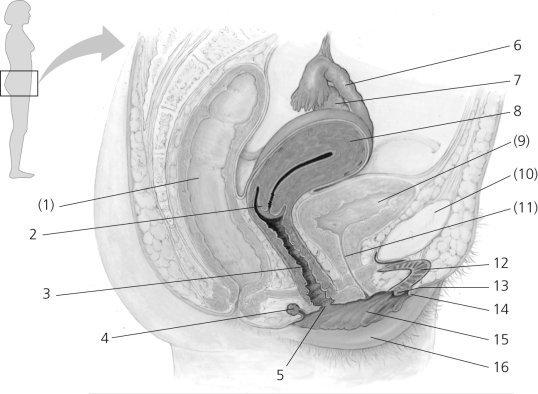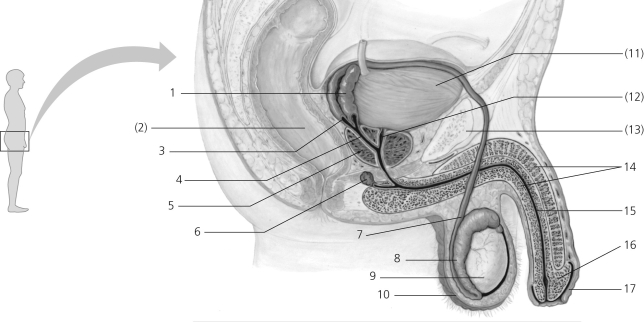A) the ovarian endometrium that is shed at the time of the menses.
B) a steroid-hormone-synthesizing structure called the corpus luteum.
C) the thickened portion of the uterine wall.
D) swept into the fallopian tube.
E) the placenta, which secretes cervical mucus.
G) A) and B)
Correct Answer

verified
Correct Answer
verified
Multiple Choice
 Figure 36.1
Some nonreproductive structures are labeled in parentheses for orientation purposes.
-In Figure 36.1, which number corresponds to the cervix?
Figure 36.1
Some nonreproductive structures are labeled in parentheses for orientation purposes.
-In Figure 36.1, which number corresponds to the cervix?
A) 2
B) 4
C) 6
D) 7
E) 15
G) B) and C)
Correct Answer

verified
Correct Answer
verified
Multiple Choice
Fertilization of an egg without activation is most like
A) placing the key in the ignition of a car but not starting the engine.
B) resting during halftime of a basketball game.
C) preparing a pie from scratch and baking it in the oven.
D) walking to the cafeteria and eating lunch.
E) dropping a rock off a cliff and watching it land in the valley below.
G) A) and C)
Correct Answer

verified
Correct Answer
verified
Multiple Choice
In sea urchins, the "fast block" and the longer-lasting "slow block" to polyspermy, respectively, are
A) the acrosomal reaction and the formation of jelly coat.
B) the cortical reaction and the formation of cortical granules.
C) the jelly coat of the egg and the vitelline layer.
D) membrane depolarization and the cortical reaction.
E) inactivation of the sperm acrosome.
G) A) and C)
Correct Answer

verified
Correct Answer
verified
Multiple Choice
The first cavity formed during sea urchin development is the
A) blastopore.
B) mouth.
C) blastocoel.
D) anus.
F) All of the above
Correct Answer

verified
Correct Answer
verified
Multiple Choice
Human trophoblasts
A) form the inner cell mass.
B) form from ectoderm.
C) are the precursors of the mesoderm.
D) are of embryonic origin and function in embryo nutrition.
E) are of maternal origin and function in embryo gas exchange.
G) B) and C)
Correct Answer

verified
Correct Answer
verified
Multiple Choice
Menopause is characterized by
A) reduced synthesis of ovarian steroids despite high levels of gonadotropin hormones.
B) a decline in production of the gonadotropin hormones by the anterior pituitary gland.
C) wearing away of the uterine endometrium.
D) an increase in the blood supply to the ovaries.
E) a halt in the synthesis of gonadotropin-releasing hormone by the brain.
G) None of the above
Correct Answer

verified
Correct Answer
verified
Multiple Choice
 Figure 36.2
Some nonreproductive structures are labeled in parentheses for orientation purposes.
-Sertoli cells are important for nourishing sperm. Where in the figure are they located?
Figure 36.2
Some nonreproductive structures are labeled in parentheses for orientation purposes.
-Sertoli cells are important for nourishing sperm. Where in the figure are they located?
A) 1
B) 4
C) 9
D) 11
F) None of the above
Correct Answer

verified
Correct Answer
verified
Multiple Choice
What is a possible outcome of oligo-ovulation, a condition in which a woman has infrequent or irregular menstrual cycles?
A) Ovulation does not occur on a regular basis.
B) Menopause does not occur.
C) Spermatogenesis in the woman's male partner is not able to occur.
D) The hypothalamus becomes inhibited by high levels of estradiol.
F) A) and C)
Correct Answer

verified
Correct Answer
verified
Multiple Choice
Which of the following correctly displays the sequence of developmental milestones?
A) blastula → gastrula → cleavage
B) blastula → cleavage → gastrula
C) cleavage → gastrula → blastula
D) cleavage → blastula → gastrula
E) gastrula → blastula → cleavage
G) A) and B)
Correct Answer

verified
Correct Answer
verified
Multiple Choice
Imagine that a woman is in the final week of her pregnancy. Her doctor gives her an injection of oxytocin. The likely result of this is that the pregnant woman would
A) undergo the loss of oxytocin receptors from her uterine smooth muscle cells.
B) stop secreting prostaglandins from the placenta.
C) undergo vigorous contractions of her uterine muscles.
D) increase the synthesis and secretion of progesterone.
E) be prevented from beginning lactation.
G) A) and D)
Correct Answer

verified
Correct Answer
verified
Multiple Choice
The vertebrate ectoderm is the origin of the
A) nervous system.
B) liver.
C) sensory system.
D) heart.
E) kidneys.
G) A) and C)
Correct Answer

verified
Correct Answer
verified
Multiple Choice
Females of many insect species can store sperm in
A) their nests.
B) the abdominal tract.
C) the cloaca.
D) the uterus.
E) the spermathecae.
G) A) and B)
Correct Answer

verified
Correct Answer
verified
Multiple Choice
 Figure 36.2
Some nonreproductive structures are labeled in parentheses for orientation purposes.
-In the figure, which number corresponds to the scrotum?
Figure 36.2
Some nonreproductive structures are labeled in parentheses for orientation purposes.
-In the figure, which number corresponds to the scrotum?
A) 3
B) 6
C) 10
D) 13
E) 16
G) B) and D)
Correct Answer

verified
Correct Answer
verified
Multiple Choice
An inactivating mutation in the progesterone receptor gene would likely result in
A) the absence of secondary sex characteristics.
B) the absence of pituitary gonadotropin hormones.
C) the inability of the uterus to support pregnancy.
D) enlarged and hyperactive uterine endometrium.
E) the absence of mammary gland development.
G) None of the above
Correct Answer

verified
Correct Answer
verified
Multiple Choice
Changes in both cell shape and cell position occur extensively during
A) gastrulation, but not organogenesis or cleavage.
B) organogenesis, but not gastrulation or cleavage.
C) cleavage, but not gastrulation or organogenesis.
D) gastrulation and organogenesis, but not cleavage.
E) gastrulation, organogenesis, and cleavage.
G) A) and E)
Correct Answer

verified
Correct Answer
verified
Multiple Choice
If a man is born with a blockage in his epididymis, he may experience
A) fragmentation.
B) low sperm count.
C) budding.
D) high sperm count.
F) All of the above
Correct Answer

verified
Correct Answer
verified
Multiple Choice
During fertilization, the acrosomal contents
A) block polyspermy.
B) help propel more sperm toward the egg.
C) digest the protective jelly coat on the surface of the egg.
D) nourish the mitochondria of the sperm.
E) trigger the completion of meiosis by the sperm.
G) A) and D)
Correct Answer

verified
Correct Answer
verified
Multiple Choice
Mature human sperm and ova are similar in that they
A) have the same number of chromosomes.
B) are approximately the same size.
C) each have a flagellum that provides motility.
D) are produced from puberty until death.
E) are formed before birth.
G) C) and D)
Correct Answer

verified
Correct Answer
verified
Multiple Choice
A primary response by the Leydig cells in the testes to the presence of luteinizing hormone is an increase in the synthesis and secretion of
A) inhibin.
B) testosterone.
C) oxytocin.
D) prolactin.
E) progesterone.
G) C) and E)
Correct Answer

verified
Correct Answer
verified
Showing 61 - 80 of 118
Related Exams